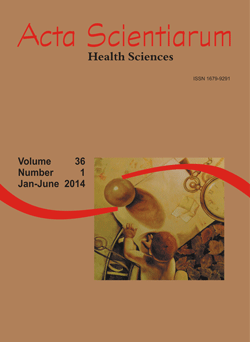<b> Acute effect of different stretching methods on isometric muscle strength</b>
Abstract
http://dx.doi.org/10.4025/actascihealthsci.v36i1.15581
This study investigated the acute effect of static stretching methods (SS) and proprioceptive neuromuscular facilitation (PNF) on the static muscle strength (SMS). Eleven young male subjects with strength training experience, performed 3 tests with a 48h interval between them, randomly selected, where each one subject carried out all procedures: a) hand grip without stretching; b) hand grip preceded by static stretching of wrist flexors muscles; c) hand grip preceded by PNF stretching of wrist flexors muscles. The Shapiro-Wilk test verified the normality of data, and a one-way ANOVA with repeated measures, followed by Tukey’s post hoc test, evaluated the differences between the groups. The significance was set at p < 0.05. Significant differences were detected between control and static stretching protocols (35.4±11.30 vs. 30.2±9.18 kgN-1; p < 0.05). The same was observed between control and PNF stretching protocols (35.4±11.30 vs. 29.1±10.05 kg N-1; p < 0.01). However, no statistical difference was found for static and FNP stretching protocols (30.2±9.18 vs. 29.1±10.05 kg N-1; p > 0.05). In conclusion, both stretching methods had caused negative effects on isometric strength, reducing its levels.
Downloads
DECLARATION OF ORIGINALITY AND COPYRIGHTS
I Declare that current article is original and has not been submitted for publication, in part or in whole, to any other national or international journal.
The copyrights belong exclusively to the authors. Published content is licensed under Creative Commons Attribution 4.0 (CC BY 4.0) guidelines, which allows sharing (copy and distribution of the material in any medium or format) and adaptation (remix, transform, and build upon the material) for any purpose, even commercially, under the terms of attribution.
Read this link for further information on how to use CC BY 4.0 properly.























5.png)







